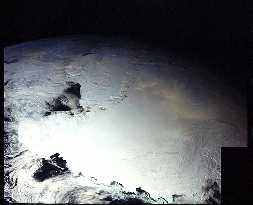This picture shows Pluto (left) and its big moon Charon (right). This picture was taken by the Hubble Space Telescope in 1994.
Click on image for full size
Image courtesy Dr. R. Albrecht (ESA/ESO Space Telescope European Coordinating Facility) and NASA.
The Moons of Pluto
Pluto has
moons. One of the moons is very big. The big moon is name Charon.
The other two moons are small. They don't really have names yet. For now
they are
called S/2005 P1 and S/2005 P2.
James Christy discovered Charon in 1978. Charon is almost as big as Pluto!
Some astronomers call Pluto and Charon a
double planet.
S/2005 P1 and S/2005 P2 were discovered in 2005. A team of astronomers found
the moons. The leaders of the team were Alan Stern and Harold Weaver. They were
getting ready for the New
Horizons space mission to Pluto. They were searching for new moons of Pluto.
They were excited when they found two new moons! They used the Hubble
Space Telescope to find the moons. S/2005 P1 and S/2005 P2 are much smaller
than Charon.
S/2005 P1 and S/2005 P2 will get "real" names after a while. Astronomers
want to be sure about the moons before they give them real names. The scientists
will observe the moons some more before they give them names.
Nobody has seen any rings around Pluto so far. We don't think it has rings,
but we don't know for sure.
You might also be interested in:

Pluto is a frigid ball of ice and rock that orbits far from the Sun on the frozen fringes of our Solar System. Considered a planet, though a rather odd one, from its discovery in 1930 until 2006, it was
...more
Charon is a moon of Pluto. Pluto has // Call the moon count function defined in the document head print_moon_count('pluto'); moons. Charon is much bigger than Pluto's other moons. James Christy discovered
...more
Of all the planets and moons in the solar system, Pluto and Charon are the two which are the most alike. They are almost the same size, and they are very close together. Pluto and Charon are so close
...more
The Hubble Space Telescope (HST) is really neat! It was first launched in 1990, but scientists started building it in the 1970's! We have found all kinds of objects like stars, nebulae and galaxies. The
...more
Astronomers are starting to search for more moons of Pluto. Pluto only has one moon that we know about. Pluto's moon is called Charon. But Pluto is very far away, so it is hard to see even with very big
...more
Makemake is a dwarf planet in our Solar System. Makemake was discovered in March 2005 by a team of astronomers led by Mike Brown. Makemake officially became a dwarf planet in July 2008. There were three
...more
Pluto is so far away, and has never been explored. Questions to answer about Pluto include the following: What are the geologic features of the surface? (pictures of the surface) If there are bare spots,
...more












